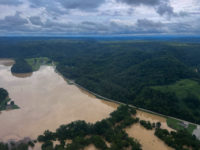In response to a January executive order from President Joe Biden, federal agencies have released plans to move climate change and resiliency front and center in their focus and decision-making processes moving forward.
The plans, which most major agencies released on Oct. 7, vary but have similarities. They include: safeguarding federal investments in infrastructure in areas vulnerable to natural disasters, sea-level rise or wildfires; addressing potential supply-chain disruptions caused by climate events; and training agency workers about their authorities to incorporate climate change adaptation into policies and decisions across the board.
The administration-wide release of the climate adaptation plans is unprecedented. But industry groups say it is unclear how the plans will be implemented, or what kinds of regulatory requirements will grow out of them.

Vining
Photo courtesy Dawson & Associates
Brian Turmail, Associated General Contractors of America vice president of public affairs and strategic initiatives, says the plans are insufficiently fleshed out. Turmail adds any new regulatory requirements could have the potential to be “disruptive” for contractors.
“Any new regulatory confusion will simply make it harder for the industry to help rebuild our economy,” he says. “Imposing new requirements that sound nice, generate good press, but do more to undermine construction employment than help the environment will only make it harder for the industry to build the greener future that everyone seeks.”
Nick Goldstein, American Road & Transportation Builders Association vice president of regulatory and legal issues, says it is not surprising that federal agencies are changing course, given that Biden ran on a platform that made addressing climate change a priority. The part of the Dept. of Transportation plan of most interest to construction companies involves including climate and resiliency as factors in DOT decisions for its infrastructure and grant programs, Goldstein says. He adds, however, that “they’ve already been doing that.”
Rob Vining, a former top official in the Army Corps of Engineers civil works program, says the Corps plans to integrate the best “observed and forward-looking climate information” into its mission will be a heavy lift. Vining says there is a deeply entrenched culture within the Corps to do things in certain ways, such as relying on historic hydrological data. He says conditions are changing so rapidly there is no comparable hydrological data to refer to.
Vining, now a senior adviser at water resources consulting firm Dawson & Associates, adds that every year, Corps leaders prioritize and justify to Congress projects based on their economic benefits. Officials now will need to revisit policies and existing regulatory limitations to find ways to monetize resiliency in prioritizing projects, he says.
Still, he adds, “The Corps has been working for some time on ‘greening up’ infrastructure,” such as using natural elements including artificial reefs instead of concrete structures, when feasible. “You can expect to see more of that,” Vining says.
Environmental advocates see the plans as a signal that the federal government is getting back on track in addressing climate change after a four-year pause. Juanita Constible, a senior advocate at the Natural Resources Defense Council, says, “I see these plans as both a restart button as well as a big step forward,” for more robust climate resilience. Having agencies release their plans together and their many shared goals suggest a “whole-government approach to climate adaptation,” Constible says. “Up until now, climate adaptation has sort of been on the sidelines.”





Post a comment to this article
Report Abusive Comment